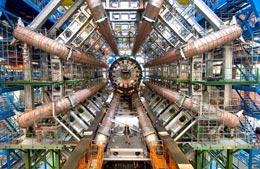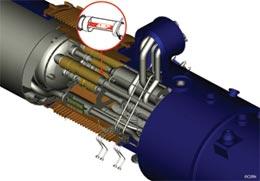Physicists get CSI on the LHC.
 The LHC is going to take some fixing.CERN
The LHC is going to take some fixing.CERNPhysicists are close to finalizing a repair plan for the Large Hadron Collider (LHC), the world's most powerful particle accelerator located at CERN, near Geneva in Switzerland.
The LHC has been out of commission since mid-September after an electrical fault destroyed part of the machine and caused several tonnes of liquid helium to leak into the tunnel (see 'Eight month delay for LHC'). The incident damaged up to 29 of the LHC's superconducting magnets and contaminated the pristine 'beam pipe' that carries protons around the collider's ring. Physicists hope to have the machine repaired and ready for first collisions by May or June 2009.
But simply replacing the damaged magnets will not be enough — physicists and engineers at CERN must also ensure that a similar accident cannot occur in the future. "The real question is how did this happen?" says Lucio Rossi, a CERN physicist who's helping to oversee the repairs.
The heart of the problem
The answer lies at the heart of the LHC's cutting-edge technology. The collider steers fast-moving protons around its 27-kilometre ring using magnetic fields of more than 8 Tesla — roughly a hundred thousand times that of Earth. High fields require high currents, and if the LHC used standard copper coils it would need its own 1,000-megawatt power station. So, to save energy and money, physicists use superconducting niobium–titanium cables. These cables, each as wide as a finger, can carry thousands of amps of current without any resistance — but only when cooled to 1.9 kelvin (–271.3°C).
“It's like a killing, the victim cannot talk.”
Lucio Rossi
CERN
The physicists investigating the failure are focusing on a faulty connection between the cables that make up the LHC's electrical 'bus' — the route for supplying current to the magnets.
During a power test on 19 September, a section of bus where two cables were spliced together began to warm up. As soon as it crossed the superconducting temperature barrier, the joint became unable to support the 8,700 amps passing through it. The connection melted and the current arced to other parts of the machine, punching a hole through the vacuum vessel and the beam pipe. Six tonnes of liquid helium escaped through the hole, doing further damage to nearby magnets.
 A faulty electrical connection between two magnets (shown in red) caused the LHC's disastrous shut-down on 19 September.CERN
A faulty electrical connection between two magnets (shown in red) caused the LHC's disastrous shut-down on 19 September.CERNThe current was so powerful that it vaporized much of the wire, so there's no way to tell for sure what happened, Rossi says: "It's like a killing, the victim cannot talk." But Lyn Evans, who heads up the LHC project, says that physicists and engineers "are sure" that a faulty splice caused the accident. The high current probably led the defective connection to gradually come undone, raising the resistance until the bus lost its superconductivity.
All the king's horses
The key to preventing a similar disaster will be detecting faults in time, Rossi says. The enormous currents inside the LHC cannot simply be switched off, as it takes around a minute for heating coils and bypass circuits to dissipate the power contained inside the magnets. In order to have sufficient stopping time, he says, "we will have to detect the effect when a precursor appears."
Fortunately, it seems that early detection will be possible. On the basis of tests conducted on 24 October, Rossi says he is confident that LHC operators will be able to detect millivolt changes in the electrical bus — indicative of an impending failure — soon enough to divert the thousands of amps coursing through the machine's cables. Engineers are also looking at the possibility of detecting tiny increases in the temperature of liquid helium around the wire, another warning sign.
The improved detection system alone should be enough to prevent a future accident of this type, says Jim Strait, a physicist consulting for CERN from the Fermi National Accelerator Laboratory, America's high-energy physics laboratory in Batavia, Illinois. "I'm highly confident that an event of the same sort will not happen again," he says.
Blowout kit
CERN physicists and engineers are also hoping to minimize the damage from future failures by providing more emergency outlets for the liquid helium inside the machine. In the minutes following the accident, the liquid helium around the bus vaporized and rapidly expanded into the surrounding vacuum vessel with such force that it was able to push magnets off their concrete stands. The damage occurred in part because the relief valves meant to prevent a pressure build-up were overwhelmed by the surge.
Evans says that the group is planning to add more relief valves to the machine. And Rossi says that they are also looking at replacing some steel bolts on the vacuum vessel with plastic ones that will fail when pressure builds up, allowing still more outlets through which helium can escape.
"That doesn't mean that there won't be faults one hasn't foreseen," warns Strait. "But improvements in vacuum relief will limit collateral damage." Making the necessary repairs and modifications to the machine in time for a restart in May 2009 will be a "big job", he adds. But, he says, "I have seen CERN do other things where the naysayers said that it couldn't be done. And they did it."



No comments:
Post a Comment